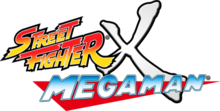Mega Man is a Japanese science fiction video game franchise created by Capcom, starring a series of characters each known by the name or moniker "Mega Man". The original game was released for the Nintendo Entertainment System in 1987, and spawned a franchise that expanded to over 50 games on multiple systems. As of October 2023, the series has sold 41 million units worldwide.
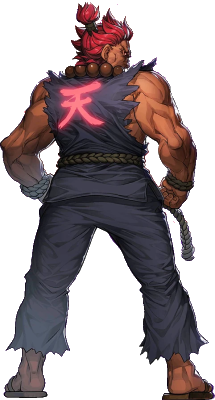
Akuma, known in Japan as Gouki, is a fictional character and the secondary antagonist of the Street Fighter series of fighting games created by Capcom. Akuma made his debut in Super Street Fighter II Turbo as a secret character and boss. In the storyline of the Street Fighter video games, he is the younger brother of Gouken, Ryu's and Ken's master. In some games, he also has an alternate version named Shin Akuma or Shin Gouki in Japanese and Oni Akuma in Super Street Fighter IV: Arcade Edition. Since his debut, Akuma has appeared in several subsequent titles and has been praised by both fans and critics.
Darkstalkers, known in Japan as Vampire (ヴァンパイア), is a fighting game series and media franchise created by Capcom. The first game, Darkstalkers: The Night Warriors, was released in arcades in 1994. The series is set in a pastiche gothic fiction universe with characters based on monsters from international folklore, and features a stylized 2D graphic style. Darkstalkers introduced gameplay concepts used in later Capcom fighting games, including the Street Fighter Alpha and Marvel vs. Capcom series.

Proto Man, known in Japan as Blues, is a fictional character from Capcom's Mega Man video game series. Proto Man first appeared in the 1990 video game Mega Man 3 as a mini-boss Mega Man had to face periodically, and was known as Break Man. At the end of Mega Man 3, it is revealed that Break Man's actual name is Proto Man, and that he is Mega Man's older brother. Proto Man made further appearances in many more Mega Man games, sometimes as a playable character, often receiving critical praise.

Keiji Inafune is a Japanese video game producer, illustrator and businessman. Starting his career at Capcom in the late 1980s, his job was as an artist and illustrator. The first two games he worked on were the original Street Fighter and Mega Man in 1987. He was then an illustrator and artist of the Mega Man series during the NES and Super NES era. For Mega Man X, he created and designed the character Zero.

Sigma is the main antagonist of the Mega Man X video game series. Created by Dr. Cain, Sigma was considered the finest of the Reploids and was the first leader of the Maverick Hunters, peacekeeping androids who defend humans against their renegade counterparts. Although he was once respectable, Sigma unexpectedly goes berserk during Mega Man X and rebels against humankind after coming into contact with the Maverick Virus. He defects to the Mavericks and assumes the role of their leader. Due to the virus integrated into his circuits, he can survive seemingly anything, and constantly returns to menace the world.

Zero is a video game character present throughout much of Capcom's Mega Man franchise, who first debuted in the Mega Man X series. He is an android and an elite member of the Maverick Hunters, an organization dedicated to defending humanity from rogue Reploids known as Mavericks. Zero also acts as a mentor and longtime friend to X, the main protagonist of the X series. He is also the titular main protagonist of the Mega Man Zero series, and has a supporting role in other series in the franchise, such as the Mega Man ZX series. He has also appeared in crossover video games as a guest character.

The Servbot, known as Kobun (コブン) in Japan, is a type of fictional sentient robot that appears in an assortment of video games and associated media developed and published by Capcom. The Servbot originated in the 1997 title Mega Man Legends, and appears in all media within the sub-series of the same name. Within series fiction, Servbots are a group of childlike robots who follow their creator, the pirate Tron Bonne, as her loyal but incompetent henchmen. The Servbots serve as a source of comic relief for the majority of their appearances.

Mega Man X2, known as Rockman X2 (ロックマンX2) in Japan, is a video game developed by Capcom for the Super Nintendo Entertainment System (SNES). The game was released in Japan on December 16, 1994, and in North America and PAL regions in 1995. It is the direct sequel to Mega Man X, released one year prior. Mega Man X2 takes place in the near future in which humans try to peacefully coexist with intelligent robots called "Reploids", with some of the Reploids going "Maverick" and threatening daily life. The plot follows the android protagonist X, a "Maverick Hunter" who has saved humanity from the evil Sigma six months earlier. A trio of Mavericks calling themselves the "X-Hunters" has arisen, intent on destroying X by luring him with bodyparts of his comrade Zero, who died in the conflict with Sigma's right hand robot named Vile.

Mega Man X6, known as Rockman X6 (ロックマンエックス6) in Japan, is a platform game developed and published by Capcom. It is the sixth main entry in the Mega Man X series. The game was first released on the PlayStation in Japan on November 29, 2001 and was later made available in both North America and Europe. The game was released for the Microsoft Windows in different parts of Asia in 2002.
Maverick Hunter was the codename for a cancelled first-person shooter video game in the Mega Man franchise that would have been developed by Armature Studio and published by Capcom. It was intended to be a darker entry in the Mega Man X series. Mega Man artist and producer Keiji Inafune was responsible for establishing the western-designed game and Adi Granov was responsible for X's new design. It was intended to be the first of a trilogy of games, where players controlled its protagonist X in the first two games and then as Zero for the third. The game would have had similar platform elements found in earlier Mega Man X titles.

Mega Man X is a series of action platform games released by Capcom. It is a sub-series of the Mega Man franchise previously developed by the same group with Keiji Inafune acting as one of the main staff members. The first game was released on 17 December 1993 in Japan on the Super Famicom and the following month on the Super NES in North America. Most of the sequels were ported to Microsoft Windows. The gameplay introduces new elements to the Mega Man franchise in the form of Mega Man's successor X including his new skills and power ups in the form of armors while retaining the decision to decide which boss fight first. The first six games in the series were compiled in the anthology Mega Man X Collection and then the Legacy duology collected the entire eight main games.

Street Fighter IV is a 2.5D fighting game published by Capcom, who also co-developed the game with Dimps. It was the first original main entry in the series since Street Fighter III in 1997, a hiatus of eleven years.
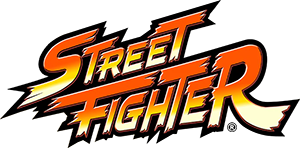
Street Fighter, commonly abbreviated as SF or スト (Suto), is a Japanese media franchise centered on a series of fighting video and arcade games developed and published by Capcom. The first game in the series was released in 1987, followed by six other main series games, various spin-offs and crossovers, and numerous appearances in other media. Its best-selling 1991 release Street Fighter II established many of the conventions of the one-on-one fighting genre.
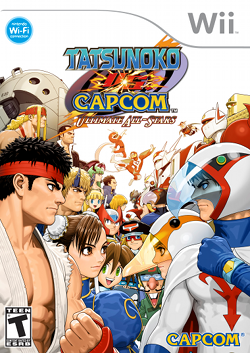
Tatsunoko vs. Capcom: Ultimate All-Stars is a crossover fighting game developed by Eighting and published by Capcom. The game features characters from both Capcom's video game franchises and various anime series produced by Tatsunoko Production. It was originally released in Japan for arcades and the Wii video game console in December 2008 as Tatsunoko vs. Capcom: Cross Generation of Heroes. Following high demand from international fans, Capcom worked with Tatsunoko to resolve international licensing issues and a second version, Ultimate All-Stars, was released for the Wii in North America, Japan, and Europe in January 2010, featuring additional characters and online multiplayer.

Mega Man, known as Rockman in Japan, is the title character and the protagonist of the Mega Man series by Capcom. He was created by Akira Kitamura for the first Mega Man game released in 1987, with artist Keiji Inafune providing detailed character artwork based on Kitamura's pixel art design.
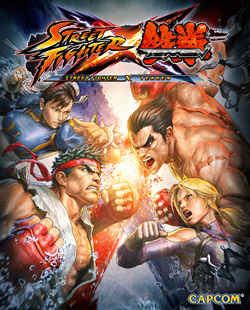
Street Fighter X Tekken is a crossover fighting game developed and published by Capcom and released in March 2012 for the PlayStation 3 and Xbox 360, in May for Windows and in October for the PlayStation Vita. The game features characters from both the Street Fighter franchise and Namco's Tekken series. In the game, each player selects two characters respectively and face other as duos in tag team fighting matches, with the objective to knock out one of the members from the opposing team. In addition to the game's multiplayer modes, the game also features a single-player Story mode with a plot revolving around a mysterious object called the "Pandora".

Mega Man Legends 3 is a cancelled video game set to be the sequel to Mega Man Legends 2 and the fourth game in the Mega Man Legends series. It was announced for the Nintendo 3DS on September 29, 2010, during a Nintendo press conference for the 3DS.
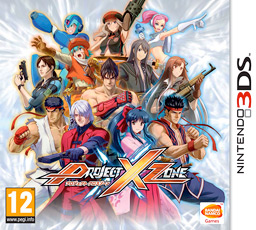
Project X Zone is a crossover tactical role-playing game for the Nintendo 3DS developed by Monolith Soft with assistance from Capcom and Red Entertainment and published by Namco Bandai Games. The game is a follow-up to the 2005 video game Namco × Capcom and features characters from Namco Bandai, Capcom, and Sega. The game was released on October 11, 2012 in Japan; June 25, 2013 in North America; and July 5, 2013 in Europe. The game received mixed to positive reviews on release; praise went towards the game's cast, combat system, and presentation, but criticism was directed at its repetitive gameplay and confusing storyline.
